
The shift to online learning has forced schools to completely rethink recruitment, from the kinds of programs they offer to the way they promote them. With extended application deadlines, different course options, and in many cases, a new online learning platform, it’s important for schools to communicate these changes to prospects as well as showcase their benefits.
What better way to do so than with strategically timed email workflows highlighting different elements of your online courses? Studies have shown that prospects prefer to receive educational communications via email – and for good reason. Schools that deploy email workflows provide prospects with the right information, resources, and content at the right time.
Whether your school wants to update its pre-existing workflows for online courses or create new ones, read on to discover some education-specific email tips from our marketing experts!

Updating Lead Nurturing Workflows to Promote Online Courses
As you’ve probably heard time and time again, all digital marketing initiatives should be strategized with the enrollment journey in mind – but it’s worth reiterating now that schools are updating and changing their marketing strategies to promote online courses.
As you do so, make sure that your strategy includes a variety of activities that target leads in different stages of the journey. That way, every prospective student will receive the information they need to apply.
When it comes to lead nurturing workflows, however, you can capture the entire enrollment journey in one campaign. These workflows consist of strategically spaced out emails, moving from general information to more specific messaging to gently nudge prospective students towards enrollment.
Lead nurturing workflows typically include 6-8 mails, with each one highlighting a different aspect of your school. To make these workflows online learning-specific, you could include information about online programs, remote learning resources, and any online services your school offers its students.
Example: An online course-focused lead nurturing workflow triggered by an inquiry submission.

The length of your enrollment journey will also impact the length and spacing of your lead nurturing workflows. The above example is fairly aggressive, with messages being consistently sent out shortly after the initial inquiry. As a result, it’s a great template for schools that offer shorter courses, like language schools, as you can provide prospects with the vital information they need before deadlines approach.
However, university or business school prospects typically spend a long time researching different higher ed options, so these schools should opt for a more spread out workflow that contains more mails.
Example: A mock lead nurturing workflow for a business school’s online program.

Building Program-Specific Workflows Using Marketing Automation for Schools
Although you will likely include online course information in your general lead nurturing workflows, it’s good practice to also create workflows specific to your various online programs. After all, the quality of your courses will ultimately play the biggest part in your prospects’ decision-making process – and it has only become more important now that on-campus activities and location aren’t contributing factors.
Online course-specific workflows provide in-depth insight into particular courses and programs. In order to provide this personalized information, you’ll first need a way to gauge which course leads are interested in.
A robust CRM with education marketing automation functionality can allow you to segment prospects based on their program of interest by creating enrollment triggered by the fields in their contact profile or imported from lead capture forms.
Example: WU Executive Academy’s inquiry form, which allows prospects to select which programs they want to learn more about. These fields can serve as a basis for program-specific workflow segmentation.

By integrating your website to a CRM, prospects can be automatically placed in different workflows based on the online courses they are interested in.
As for the content of these segmented workflows, you should feature different aspects of your online courses such as the course material, the online instructors, and the practical skills that prospects will develop.
Just as you did with the more general lead nurturing workflows, start simple and move into the specifics. If prospects are submitting an inquiry form, they’ll expect to hear more general info about their program of interest first.
From there, you can get creative with your messages in order to keep prospects opening your emails even after getting the information they were originally looking for. For instance, you could dedicate an email or two to information related to the course subject area. Although these emails are not directly admissions-related, your prospects will likely find them informative and entertaining.
Your school may also want to spotlight its instructors in this workflow to show that, although prospects can’t speak to professors in person, they can still get that one-on-one interaction online.
Example: A video from EC Washington spotlighting a teacher at the language school. Videos like this are great content offers to include in your program-specific workflows.

If your school has different deadlines or application requirements for its online courses, program-specific workflows will be especially valuable to your prospects. Near the end of the workflow, you can provide prospects with detailed, accurate admissions information before applications are due.
Example: An email detailing application information specific to Harvard’s Online Master’s in Education program.
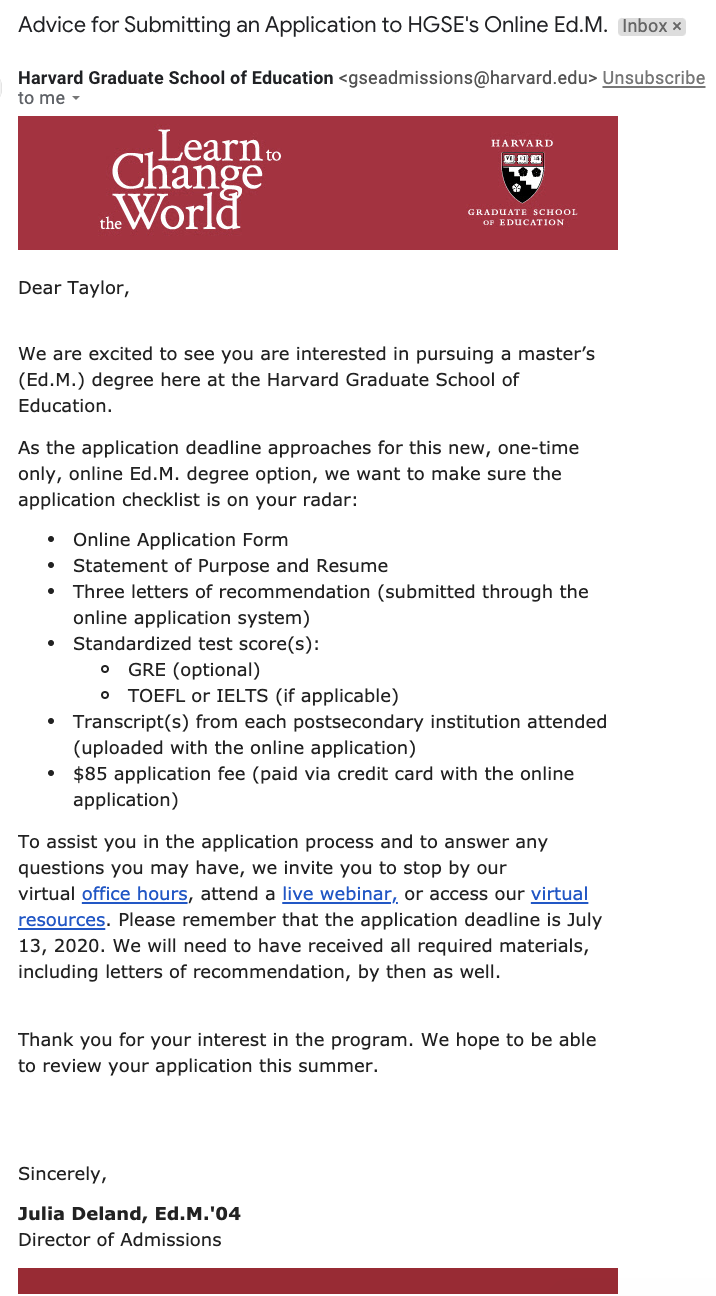
It’s also important to note that creating workflows takes a lot of work. You have to create the individual emails, build the sequence, and set up the workflow triggers. As a result, if your school offers a wide range of online courses, you may want to instead create more general workflows for students interested in different faculties. The more specific your workflows, the more effective they’ll likely be, but it’s always important to consider your school’s resources and how you want to allocate them before embarking on a new digital marketing tactic.
Using Education Marketing Automation to Promote Your Events
When it comes to recruitment events, email marketing will likely be the cornerstone of your school’s promotional strategy. Yes, you’ll post about it on social media, and share the event details to your website, hoping that prospects stumble across the details online. But an email workflow ensures that your contacts not only know about the event, but are reminded of it when the date approaches.
Since prospective students are unable to visit your school or connect with admissions officers in person, virtual campus tours, webinars, livestreams, and other digital events are a lifeline for many schools offering online courses. Since these events are so important, you should ensure you’re pulling out all the stops when promoting them – and creating email workflows dedicated to your school’s online events will help maximize attendance.
Before you start crafting workflows for your virtual events, consider who you want to invite first. Since attending an event takes more time out of your prospects’ day than scanning a social media post or reading a blog, this recruitment tactic is usually aimed at leads who have demonstrated a high degree of interest in your school.
To sift out these leads in your contact database, you can adopt a lead scoring system to identify those most likely to attend. This involves giving leads a score from 1-100 based on their perceived interest in your school as well as their eligibility for your online programs.
Schools can award high scores for leads with favorable demographic characteristics related to age, country of origin, and native language, to name just a few. Engagement-based lead scoring involves giving high scores to those indicate strong interest through activities such as opening emails, spending significant time on your site, and following your school on social media.
Example: A lead scoring matrix for a sample business school.

Then, using your CRM, you can set up triggers to automatically tally scores for pre-existing and incoming leads. If new information is added to a particular contact profile, or they engage with your school, their score will update accordingly.
Example: The lead scoring setup feature in HubSpot CRM. As you can see, you can add both positive and negative scores based on favourable and unfavourable qualities to create more accurate lead scores.
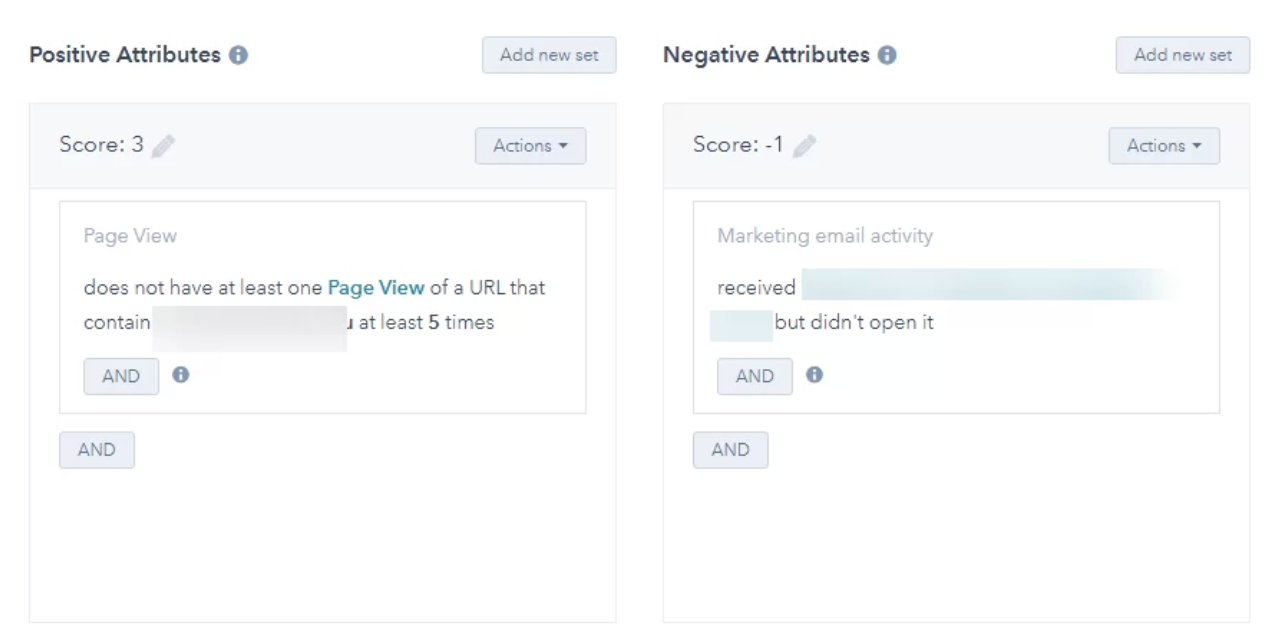
Once you’ve set up your lead scoring system, you can use your CRM to trigger an event workflow once a lead completes certain actions or obtains a specific score.
Example: The event trigger feature in HEM’s Mautic CRM. You can trigger specific emails or email workflow campaigns based on certain actions.
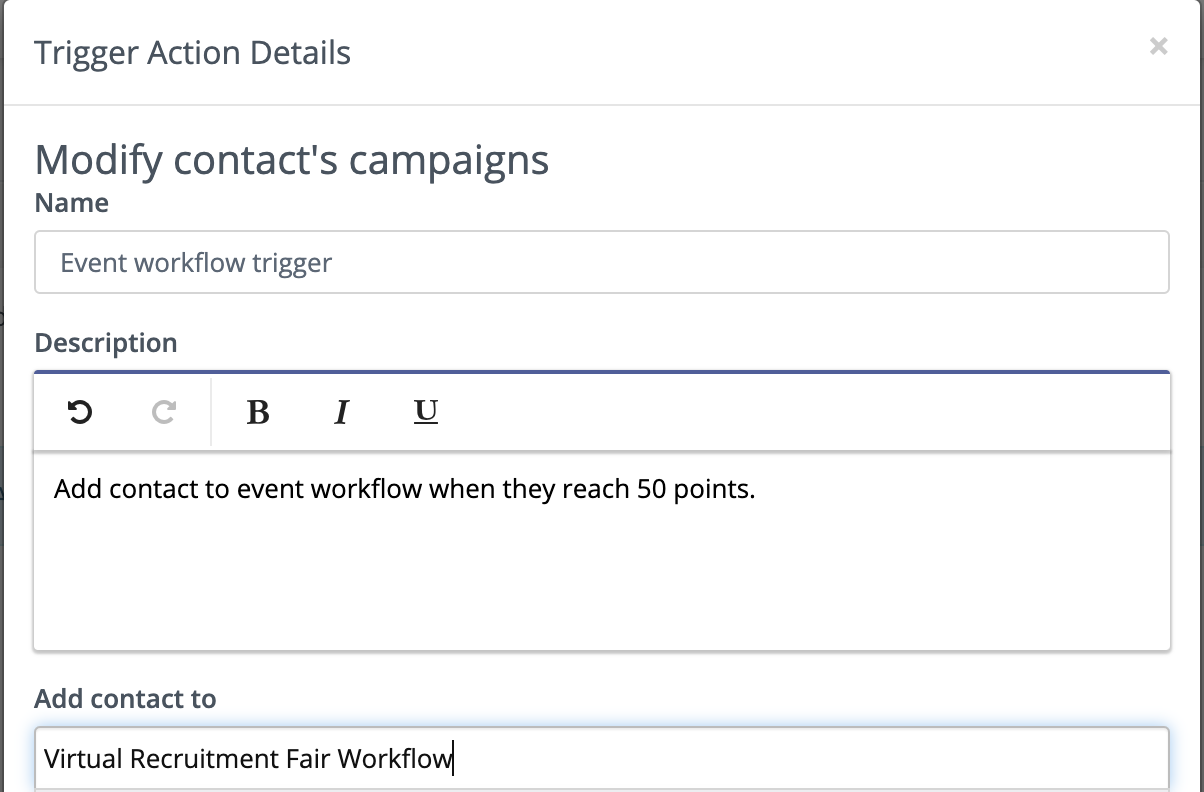
Now that you’ve configured your lead scoring system to trigger an email workflow, you can focus on the fun part: the workflow itself.
Event-specific workflows tend to be shorter than lead nurturing workflows, as you want to start sending out emails shortly before the event date.
For maximum impact, start with a general invitation, and then, depending on how robust you want the workflow to be, include additional emails with more event details or information on the presenters. But always finish the workflow off with a reminder email close to the event date.
Example: A webinar email invite from Ave Maria Law School. This is the perfect initial email for an event workflow, and it’s colourful design is great for catching a prospect’s attention.

When it comes to promoting an online event, getting prospects to register is one hurdle, but getting them to attend is another. Luckily, rectifying this issue is as simple as creating an alternate branch of the workflow that is triggered when a prospect registers for the event. This way, you won’t bombard those who’ve already registered with additional email invites, and can instead send them a simple reminder email right before the event.
Example: A short webinar email workflow. As soon as a lead registers for the event, they will be added to the ‘Registered’ branch – otherwise, they’ll receive the emails in the ‘Undecided’ branch.
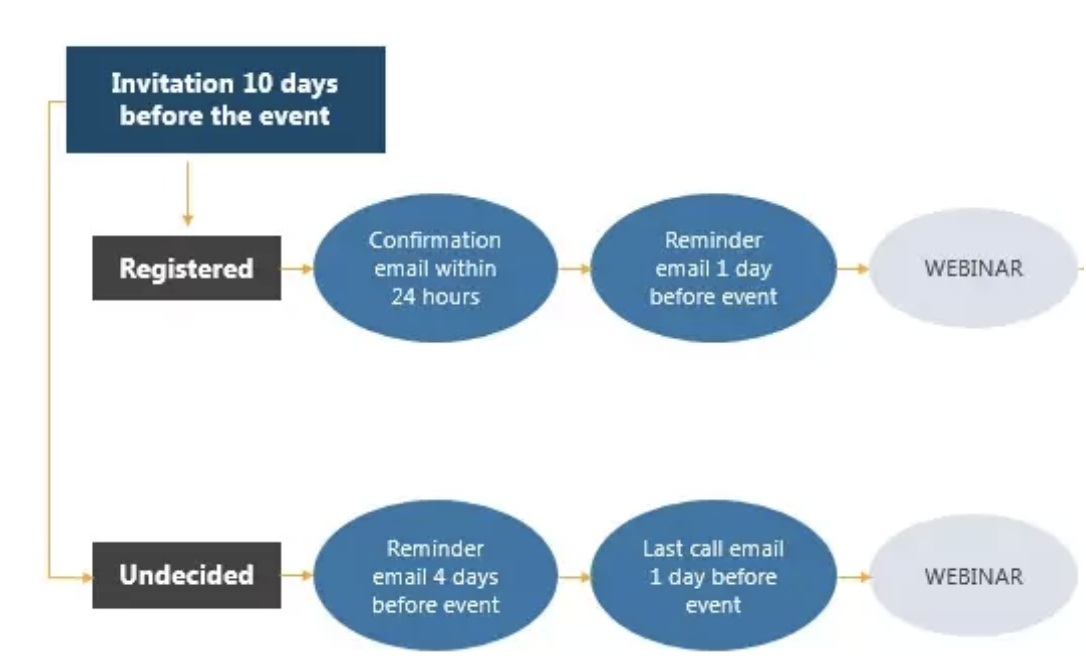
It is also beneficial to add a follow-up email to your workflow which will be sent out in the days following the event. You may want to include a recording of the event for those that didn’t attend, or offer those that did attend some extra resources to better get to know your school.
Example: Follow-up emails for attendees and absentees of one of HEM’s recent webinars. Regardless of whether a lead attended or not, they can view a recording of the event, download a copy of the deck, and get in touch with one of our representatives.

If you put a lot of resources into your online events, you want to maximize attendance. Email workflows are one of the best ways possible to ensure that you get the ROI you want.
Promote Online Courses Through Remote Learning Software Workflows
While your school may have had some sort of lead nurturing or event-specific workflows in place before switching to online courses, this is one email marketing strategy that is specific to the current context.
In today’s education marketing sector, it’s imperative for schools to offer resources that offer insight into their learning management system (LMS) for remote courses. Today’s prospects want to feel confident in the quality of education they’re receiving, and explaining not only what they will learn but how they’ll learn contributes to this confidence.
Email workflows are a great way to show off your online learning platform from all angles. Since every school has a different approach to online learning, it can be useful to include an email highlighting your unique methodology, and how it will provide the best education possible.
Example: A mock email from a career college discussing the interactive learning platform it uses.
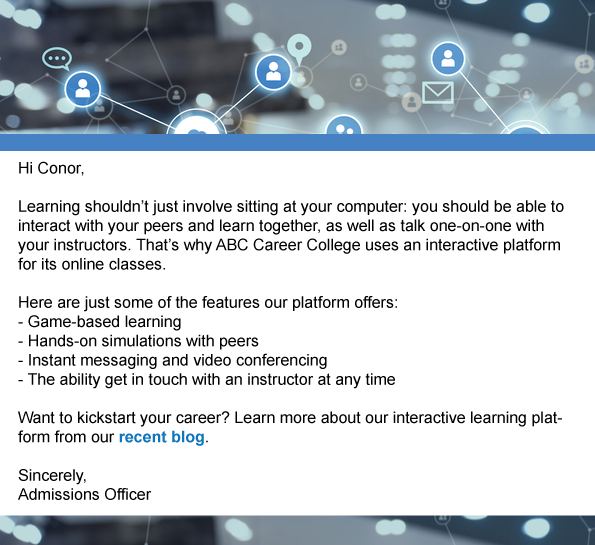
Another way to showcase your online learning platform is by including content offers in your workflow sequence. You could include videos that walk through your remote learning platform, for instance, or link to a blog post that highlights some of the platform’s features.
Example: YouTube Video from the University of Essex walking through its online course software. Schools could embed a video like this in an email, or share a link to it, to make their emails more entertaining and engaging.
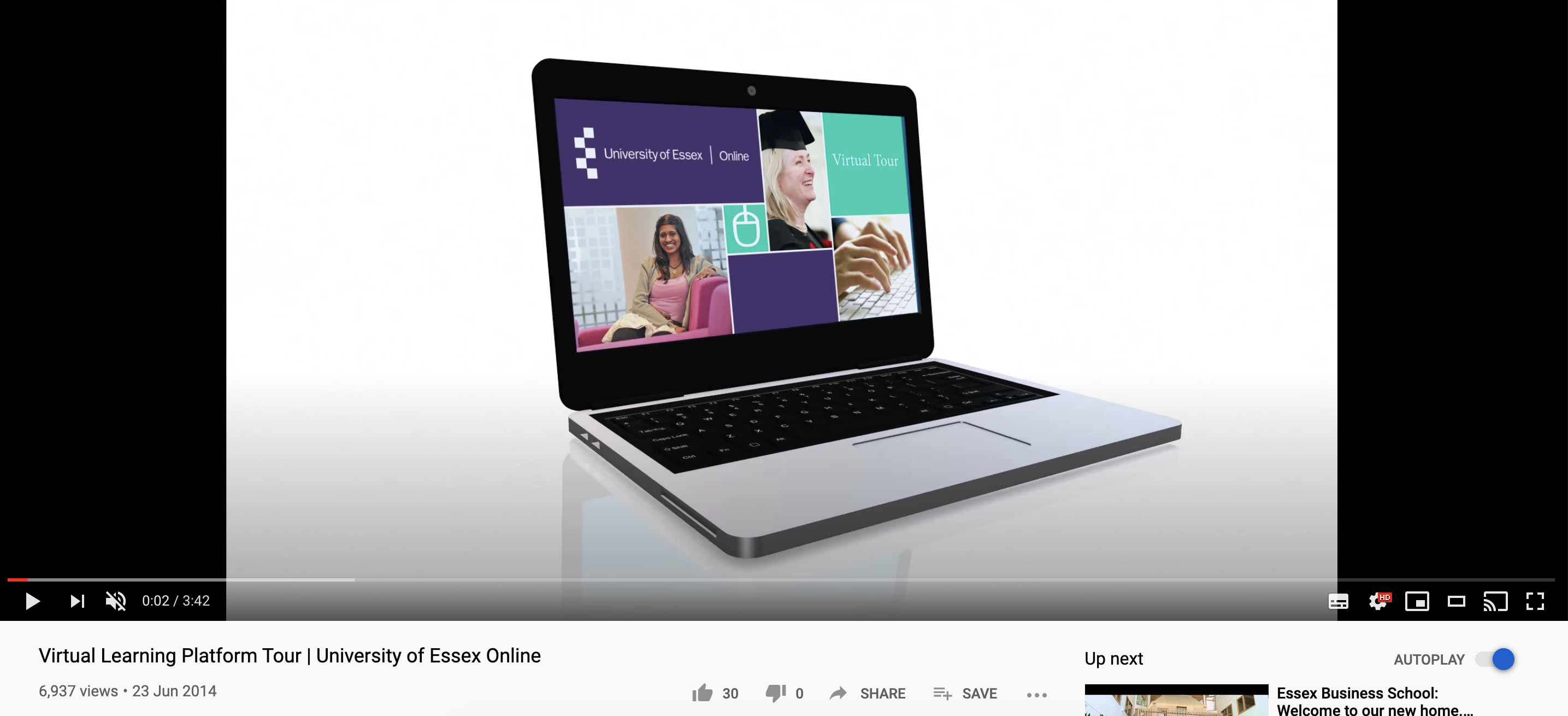
Schools may also want to consider offering free online course trials, and can use email workflows to encourage prospects to sign up. Free trials provide the most hands-on exposure to your school’s online learning software, so they’d be a great addition to not only your email workflows, but your digital marketing strategy.
Example: Mock email from a language school offering a free trial for its online English course.
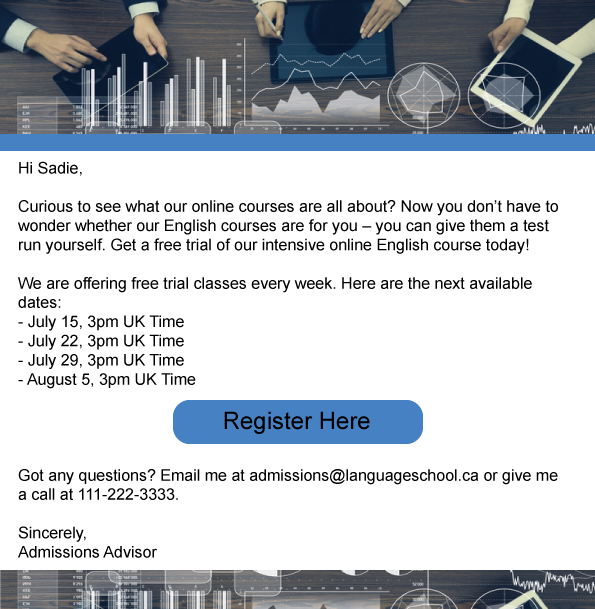
Of course, these mails can be incorporated into more general or program-specific workflows promoting your online course offerings. However, creating specific workflows related to the capabilities of your LMS could be a great option, particularly if you are looking to reengage leads who were interested in your on-campus programs but have lapsed since the lockdown began.
Creating online-learning specific workflows will help deliver the information that prospects are most interested in during this time. These emails anticipate the kinds of questions that prospects have about your online learning capabilities, and provide answers that will help them make the right decision.
Create Reminder Workflows Built Around Deadlines
The sudden surge of COVID-19 around the world interrupted the set schedules of many schools. Classes were suspended, many students returned home, and in some cases, summer courses were postponed or cancelled.
As a result, many schools shifted their application deadlines for future terms in order to provide extra flexibility to prospective students. While this decision was in the best interest of prospects, it’s important that they are aware of the changes so they can submit their applications on time.
Through marketing automation for schools, you can create workflows around certain dates. That way, when the deadline approaches, the prospect will be sent a series of reminder emails in the weeks leading up to it.
Example: Excerpts from a HubSpot workflow which sends reminder emails to prospects that the deadline to apply to their online course of interest is approaching.
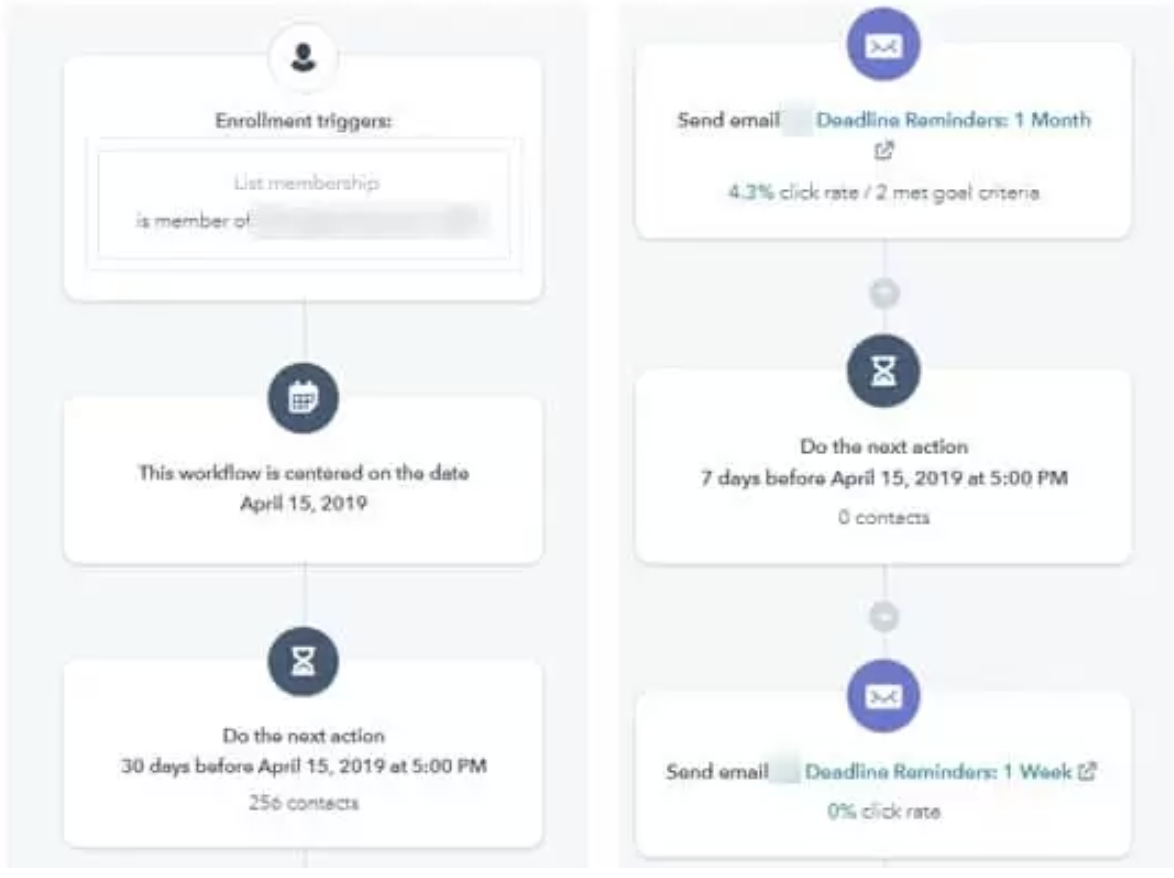
These emails will likely be short and sweet, both in sequence and in copy. While lead nurturing workflows are all about subtly inching prospects towards enrollment, the motive of these emails is much more straightforward, so there is room to be a bit more direct.
Example: Deadline reminder email from Stetson Law School. The copy is kept to a minimum, offering only the most essential information, and an ‘Apply Now’ CTA is foregrounded.

Creating Workflows for Applicants Using Education Marketing Automation
Many prospective students – especially those applying to universities and business schools – will apply to multiple schools, so your recruitment work is not done once a prospect has clicked the ‘submit application’ button. You need to show them why your institution is the best choice.
A great way to do this is by creating an email workflow that is triggered by an application submission. The aim of this workflow is twofold: to offer prospects any last-minute information they may need to convert, as well as get prospects excited and prepared for their online studies through helpful resources.
Example: An email from Yorkville University highlighting the unique selling points of its online BBA program. Showcasing how your school stands out amongst the competition is a great way to convert applicants who are still on the fence as to which institution to attend.

You can also offer online learning tips, resources for remote learning, and other helpful information in your workflows. Doing so demonstrates that your school is committed to supporting its students – even before its online courses start. The trust that’s built as a result could be the factor that convinces prospects to choose your school.
Example: Sample workflow for a career college.

Creating and optimizing email workflows for your online courses requires ample attention to detail, but the time and energy your school devotes to its email marketing campaigns will, without a doubt, pay off. In fact, the ROI for email marketing could be as high as 440% according to Campaign Monitor. And the more targeted, segmented, and strategic your email workflows are, the closer your school will get to this mark.






